Chapter 4 ~ The End of High Economic Growth and the Oil Crisis ~ Showa 40’s

To summarize the 1965s, GNP became the second largest capitalist country in 1968, the peak of the high growth period represented by the two events of the 1970 Osaka World Exposition, and 1971. It was an era of major changes in Japan’s economic history, with the transition to a low-growth era represented by the Nixon shock (announcement of the suspension of gold conversion of dollars) and the 1973 oil crisis triggered by the Middle East War.
As a concrete social phenomenon, it was an era when the post-war baby boom generation became mature and the consumption behavior and cultural behavior of new values were pulled.
Social events and phenomena such as the 1965 electric guitar boom, the 1969 Todai Yasuda Auditorium Incident, and the 1972 Japanese Red Army “Asama Sanso Incident” have caused the baby boomer generation to collide with old Japanese values and are new. It was the result of acting on values, which resulted in a decade of new values and consumption generations.
How did the Japanese consumer electronics industry develop in Akihabara in the 1965s? First, let’s sort out the 1965s of Japan as a whole.
Showa 40’s of Japan as a whole (economy)
 |
| Akihabara Electric Town during the Toden era (1968) |
Due to the special demand for preparations for the Tokyo Olympics and the reaction to the high growth in the 1955’s, there were many glamorous events such as the holding of the Tokyo Olympics in 1964, but Japan as a whole was in a recession due to difficulty in recruiting.
After bottoming out in 1965, the economy entered a rising period again and enjoyed the so-called “Izanagi economy” until the summer of 1970. The real growth rate of economic growth from 1966 to 1970 reached an annual average of 11.6%. Around this time when GNP became the second largest in the world, the terms “economic power” and “economic animal” came to be heard. In particular, exports protected by the fixed exchange rate system were strong, and the Japanese economy grew rapidly along with capital investment and personal consumption. As a result, international export issues such as voluntary export restraints in the textile industry and dumping of home appliances It will receive severe opposition from society, leading to economic friction.
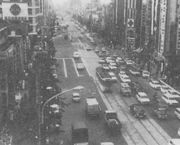 |
| Chuo-dori in the early 1965s |
In addition, the distortion of growth from the 1955’s began to become apparent, and the “shadow” of growth such as labor shortage, rising consumer prices, industrial pollution, lagging social capital, housing problems and transportation problems in urban areas is the society. It started to become a problem. On the other hand, it was also an era of ideology linked to student movements such as consumer movements and boycotts of Japanese products.
At the peak of the feast of high economic growth, in 1971, the year after the World’s Fair in Osaka Senri was held, the US government announced that the dollar would not be converted into gold in order to defend the dollar. This is the so-called Nixon shock. In August, the new market price was 308 yen to the dollar, which will not last long and will change to a floating exchange rate system. Even so, Japan at that time had a high potential growth rate, and the economy recovered the following year, and there was a tendency for inflation. In October 1973, the so-called oil crisis occurred, and prices of all products, not to mention petroleum-related products, were raised, causing frenzied prices. The government has implemented aggregate demand control policies and monetary policies to control inflation. Japan’s high growth, which is based on the premise of conventional cheap oil, will take this opportunity to shift to a low-growth era. Furthermore, the frenzy of prices has subsided as the government’s tightening policy has permeated, but since the second half of 1974, the financial tightness of companies has worsened and the economy has entered an unprecedented major recession.
Showa 40’s of Japan as a whole (Culture)
 |
| Pedestrian zone begins in Akihabara (June 10, 1973) |
With the rise of the baby boomer generation, the 1965s will be an era of cultural diversification.
In terms of fashion, jeans became a big hit in 1970, and in the same year the “Women’s Lib” movement and the formation of “Chupiren” in 1972 were also symbols of the era of gender equality and action. The Beatles came to Japan in 1966 and launched “Playboy”. Keiko Ochiai and Masaru Doi played an active part in the midnight broadcast. The Ivy tribe became popular from around 1965, and around 1970, young women were called “Annon” (readers of the popular magazines “An An” and “Nonno” at that time), and they liked domestic travel. Has launched the “Discover Japan” campaign, and even at the general public recognition level, it has shown to the public that it has caught up with Europe and the United States.
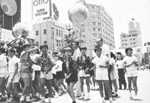 |
| From the Pedestrian Zone Parade (June 10, 1973) |
On TV, NHK’s morning serial drama “Ohanahan” started in 1966, Crazy Cats “Shabontama Holiday”, and Makoto Fujita’s Maeda cracker “Tenamonya Sandogasa” are popular or , “Astro Boy”, “Obake no Q-taro”, anime, “Ultraman” series, etc. are gaining popularity among children, and while popular programs continue to appear, “Big things are good (Morinaga Chocolate: 1967)” “It’s okay to be naughty. I want you to grow up strong (Marudai ham: 1968)” “Oh! Moretsu! (Maruzen Oil: 1970)” “Narrow Japan, where to go so quickly (traffic safety slogan: 1973)” It was an era when such masterpiece CMs appeared one after another, and consumers began to seek fun, good image, and space.
Home Appliance Industry / Akihabara Showa 40’s
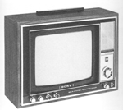 |
| 1968.10 Sony / Color TV / KV 1310 / Trinitron Unit 1 (World’s first all-transistor color TV) |
>
Although it was an era of such turmoil, the consumer electronics industry continued to grow steadily due to the rapid growth of the main pillar of “color TVs” and the consumption demand of baby boomers.
The household penetration rate of television increased from 8.3% in 1965 to 91.7% in 1970, and the penetration rate of color television increased from 7.1% in 1970 to 73.1% in 1975.
In the latter half of the 1965’s, in addition to TVs, stereos, cassette recorders, refrigerators with freezers, and coolers became available, and as home appliance manufacturers set up mass production systems, prices would fall, and as a result, demand would increase again. It created a virtuous cycle of “mass production and mass consumption.”
In addition to the color TV and cooler that I longed for, I added a car (CAR) and called it “the new three sacred treasures” and “3C.”
 |
| 1967.11 Sharp / Black and white TV / 12T-P3 / Pure tiger (first domestically produced pure transistor TV) / 45,800 yen |
Also, as I mentioned earlier, as the baby boomer generation becomes the main consumer, I become more sensitive to the price and quality of products, and from purchasing to have everything that is necessary as before, my hobbies and There was a growing tendency to buy products that suit their tastes. The most typical example is audio equipment, and in addition to specialized manufacturers, home appliance manufacturers have created audio-specialized brands such as Technics (Matsushita Electric), AUREX (Toshiba), Lo-D (Hitachi), and are particular about young people. Providing products that respond, the market has become more active, including specialized manufacturers. In addition, the start of commercial broadcasting FM in 1970 caused a boom in cassette-type recording (air check), and the stereo with a cassette deck was a longing for Young.
 |
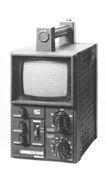 |
| 1974 / Mitsubishi / Wind fan / WF-90 / Kurupisha / 34,800 yen | 1972.9 Matsushita / Portable Radio / TR 505A TR 505A |
 |
 |
| 1966.5 Sanyo / Washing machine / SW-500 / Home laundry (single layer type fully automatic) / 53000 yen | 1973 Matsushita / Radio / RF-888 / Barking, Couga |
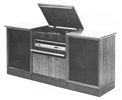 |
 |
| 1970 Pioneer / Stereo / S-88 (separate type) | 1969 Toshiba / Cleaner / VC-60EK / 21000 yen |
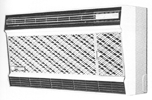 |
|
| 1971 Mitsubishi / Air Conditioner / MS-22RE / Kirigamine | |
Furthermore, the enhancement of credit and loan systems has greatly contributed to the expansion of purchasing, especially among the younger generation.
 |
| Asahi Musen Headquarters Building at the time of completion (1974) |
Focusing on the home appliance industry, the problem of home appliance distribution that erupted in the latter half of the 1955’s was the legendary “Atami Talk” among home appliance related people, and Matsushita Electric founder Konosuke Matsushita (then president) After listening to the opinions of representatives of home appliance distribution, he once again stood at the forefront as the general manager of the sales division, took drastic solutions, and greatly contributed to the stability of the industry.
On the other hand, socially, as mentioned earlier, the consumer movement has become active, and the consumer electronics industry has sometimes been struck by the double price problem of color TVs.
In the distribution industry, just as manufacturers are expanding their production facilities, the distribution industry is also influenced by the theory of American-style chain stores, and so-called “supermarkets” have begun to emerge in the town. In addition, stores have become larger to support mass consumption.
Akihabara’s stores have also been affected by these changes, and the number of stores opening in the suburbs and stores increasing in size and floor space have increased.
Opening stores outside of Akihabara is a matter of judgment, and there is no way to hope for Akihabara’s customer attraction rate and sales efficiency in other areas, and even at that time, many stores withdrew due to the inefficiency of stores in the suburbs. On the contrary, some stores actively increased the number of stores.
 |
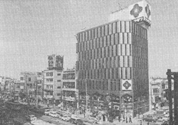 |
| Yamagiwa main store building (1965) | Yamagiwa Main Store Building Phase 1 construction completed (April 1, 1967) |
The rapid progress of Japanese building technology and the diversification of consumer needs, as symbolized by the completion of the Keio Plaza Hotel (47 stories, 170 m), the first skyscraper in the Shinjuku subcenter in 1971. With the background of reading the times when mass display is required, the stores in Akihabara are rapidly becoming larger. Buildings began to stand one after another in the latter half of the 1965’s.
In addition, the Toden was withdrawn, and a pedestrian paradise began to be implemented from 1973, and the original form of the current townscape was being completed at the end of the Showa 40’s.
References:
“History of Chiyoda Ward (published by Chiyoda Ward)”
“The Akihabara (Nikkei Sangyo Shimbun)”
“Yamagiwa 60 Years of History”
“Laox 50 Years Corporate History”
“LOOK BACK JAPAN (Across SS selection)”
